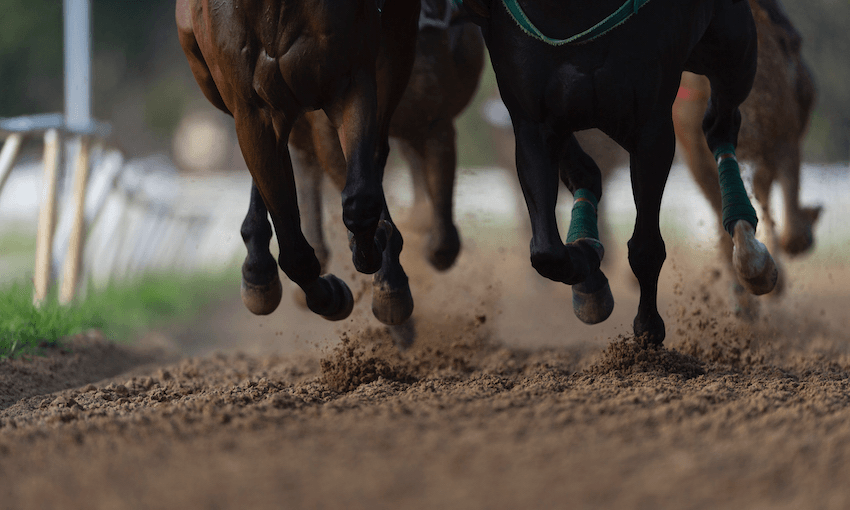The same week Melbourne Cup favourite Anthony Van Dyck was put down, three horses in New Zealand races suffered similar fates – and their deaths went unnoticed by most of us. It’s a sadly familiar story in a ‘sport’ that doesn’t deserve the name, writes Sandra Kyle.
Two weeks ago, viewers watching the Melbourne Cup saw Anthony Van Dyck pull up on the home strait. The four-year-old topweight, a race favourite, received immediate veterinary care but the fetlock fracture couldn’t be treated and he was put down.
Across the ditch the day after, on November 4, two New Zealand horses had similar tragedies at the Avondale Jockey Club in Auckland. As recorded in the stewards’ report, three-year-old gelding Hand Over sustained a shoulder injury in race number one and six-year-old gelding Forgetz fractured his leg in race number five. Neither of these conditions could be treated, and both horses were euthanised. Three days later, on Saturday November 7, the stewards’ reports show seven-year-old gelding Kamanda Lincoln was euthanised after his race at Riccarton in Christchurch. As far as I can see, there has been no reporting of any of these deaths in the mainstream media.
The deaths of Forgetz, Hand Over and Kamanda Lincoln bring the total number of racecourse fatalities in New Zealand this year to 10, as recorded by stewards’ reports, while last year 19 New Zealand horses died as a direct result of racing.
Make no mistake: horse racing kills racehorses. To call it a “sport” is a cynical euphemism. For sure, it is a competition that involves skills and fitness, but there is only one party who is a willing participant in this competition. Horses do not want to race, but are forced to. When it all goes tragically wrong the victim is the one who had no say in the matter, and the one who didn’t want to compete in the first place.
We should stop calling horse racing a sport and call it for what it is: entertainment and gambling – a chance for people to have fun and excitement, dress up and party, and make money by betting on the lives of innocent, vulnerable creatures. And for every horse who dies on the track, there are hundreds more who sustain injuries, and nose and lung bleeds caused by the extreme exertion they are required to undertake when running a race.
The industry says the animals are loved and cosseted, but there are a number of serious animal welfare problems associated with horse racing. As well as exposing horses to significant risk and injury, racing involves striking the horse with a whip, inflicting pain and fear on the animal. In New Zealand there are rules about the number of strikes during most of the race, but from the last 100 metres it can be used “at the rider’s discretion”. A jockey can only use the whip five times through most of the race, but is pretty much given licence to flog the horse approaching the finish line, which is where most of the excesses take place. If the use of the whip in both Australia and New Zealand is deemed by race stewards to be excessive, the jockey can be fined and/or suspended for days or months. Following this year’s Melbourne Cup, jockey Kerrin McEvoy was fined $30,000 (reduced from $50,000) for excessive whipping of runner-up Tiger Moth, and given a 13-meeting suspension.
Tongue ties are another animal welfare problem in horse racing. This an unregulated practice of immobilising a horse’s tongue to prevent the horse getting their tongue over the bit during a race and to prevent “choking” during high-intensity exercise. A horse is easier to control when pressure is applied via the reins to the bit on the horse’s tongue, which forces them to be compliant. It’s not known how frequently they’re used in New Zealand, but research presented in 2017 found they were used in race horses in over 20% of race starts in Australia. Problems associated with tongue tie use include horses showing signs of pain, anxiety and distress, difficulty swallowing, cuts and lacerations to the tongue, and bruising and swelling. In 2018, their use was banned in Germany.
Horses are naturally social, plains-ranging animals, yet racehorses tend to be housed in isolation and close confinement. Stereotypical behaviour stemming from frustration, stress and inhibition of natural behaviour is not uncommon in racehorses. These include the prevalence of crib-biting (repetitive oral behaviour where the horse sucks in a large amount of air) and weaving (a repetitive behaviour where the horse sways on its forelegs, shifting its weight back and forth).
Another, hitherto hidden and unspoken problem with horse racing is “wastage”. This term refers to culling of uncompetitive animals, and includes thoroughbred horses that never make it to the racetrack and horses at the end of their career. There is currently no accurate or transparent lifetime traceability system in either New Zealand or Australia, but as last year’s shocking ABC Australian investigation highlights, there is widespread slaughter of ex racehorses there.
Surely in the 21st century we have outgrown the desire to be entertained by cruel and morally questionable activities that cause harm to vulnerable creatures. It is time to end this cruelty.
Sandra Kyle is a volunteer for Coalition for the Protection of Racehorses, New Zealand
